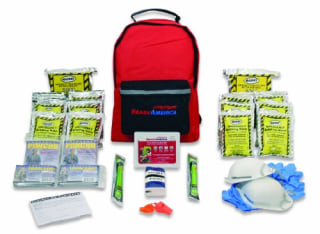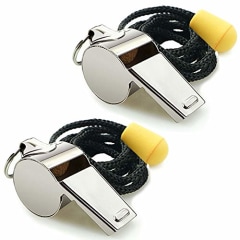With hurricanes, wildfires and nasty viruses, unfortunately emergencies are a reality these days. So could you survive off of your own food, water and other supplies for a few days if you needed to? That’s the definition of “emergency preparedness,” according to the U.S. Department of Homeland Security’s Ready.gov.
An emergency kit — sometimes called a survival kit — can help you be more prepared. Nearly half of Americans (48%) have already assembled some kind of emergency supplies, according to FEMA’s 2023 National Household Survey. If you’re not one of them, what are you waiting for? I've collected guidance from government agencies like FEMA and the CDC about what to put in an emergency kit and recommend some top-rated options below.
SKIP AHEAD How I picked the best emergency kits and supplies | Top-rated emergency kits of 2024 | Top-rated emergency supplies of 2024 | Why trust NBC Select?
How I picked the best emergency kits and supplies
Using guidance from reputable agencies like the U.S. Department of Homeland Security, FEMA, the Centers for Diseases Control and Prevention (CDC) and the American Red Cross, I selected emergency kits based on the following criteria:
- Supplies included: All of the above organizations suggest an emergency kit that includes some variation of the following:
- First aid: suitable to the size and medical need of your family
- Sustenance: water (one gallon per person per day) and non-perishable food that can last several days
- Hygiene: moist towelettes and garbage bags
- Light: flashlight
- Shelter: plastic sheeting and emergency blankets
- Communication: whistle, battery-powered or hand-crank radio (with NOAA Weather Radio, if possible), cell phone and cell phone charging cables
- Tools: disposable batteries, duct tape, multi-tool or wrench, can-opener (if kit contains canned food) and local maps
- Protection: N95 masks
- Household size: Emergency kits are designed for a specific number of people. I've included pre-made options for households ranging from two to four people.
- Top-rated: I only selected pre-made kits with at least a four star rating on the brand or retailer sites.
Top-rated emergency kits of 2024
These top-rated emergency kits have most of the supplies recommended from agencies like FEMA, the CDC and The American Red Cross. You can also supplement them with supplies of your own.
Best overall: Redfora Complete 3 Day Earthquake Bag
This three-day emergency kit includes a variety of items recommended by FEMA, the CDC and the Red Cross, plus some additional nice-to-haves, like water purification tablets, nylon rope, a sewing kit, a candle and hand warmers. The supplies are labeled and color-coated in bags that have a QR code you can scan to find out more about how to use the supplies, according to the brand. It comes in a red backpack and weighs about 10 pounds in total.
You can read a full list of the included supplies on Redfora’s website. This emergency kit does not include all the recommended shelter and communication supplies, so. you may want to supplement with things like plastic sheeting, batteries, charging tools and local maps.
Persons: 2 | Time: 72 hours | Weight: 10.5 lbs
Best budget: Ready America 72 Hour Emergency Backpack
This emergency kit has fewer supplies than our top pick but costs significantly less. It is a good starting point to build a larger kit, and it’s small enough to fit into a larger emergency pack.
You can read a full list of the included supplies on Ready America’s website. The kit does not include all of the recommended hygiene, light, shelter, communication, tools and protection supplies for a full emergency kit.
Persons: 2 | Time: 72 hours | Weight: 7.75 lbs
Best splurge: Judy The Mover Max
This kit has more supplies than our other recommendations and comes in a more durable backpack. The bright orange bag is made of PVC fabric, which is waterproof and puncture resistant, unlike a typical nylon or cotton backpack. It also has a waist-belt, which helps better distribute the heavy 15-pound weight while carrying.
All of the supplies are packaged in labeled bags and boxes to make it easier to find what you’re looking for, according to the brand.
You can read a full list of the included supplies on the Judy website. The kit does not include all the recommended shelter, communication, tools and protection supplies for a full emergency kit.
Persons: 4 | Time: 72 hours | Weight: 15 lbs
Best for one person: Blue Coolers Blue 72 Hour Emergency Backpack
Designed to have enough supplies for one person for 72 hours, this kit is lighter and smaller than most of our other top picks. It comes in a blue backpack with multiple zippered pockets, including a mesh outer pocket that’s good for stuffing things like clothing.
You can read a full list of the included supplies on Blue Coolers’ website. The kit does not include all the recommended shelter, communication and tool supplies for a full emergency.
Persons: 1 | Time: 72 hours | Weight: Unlisted
Top-rated emergency supplies of 2024
You’ll probably want to supplement any pre-built survival kit with other tools and supplies. Or you might want to build your own go-bag from scratch. Below are highly rated first aid, sustenance, hygiene, light source, shelter, communication, tool and protection supplies fit for any emergency kit.
First aid kits
A first aid kit should include a variety of supplies for treating wounds and injuries. You should add personal items like medications and emergency contacts, according to the American Red Cross.
Whistles
Whistles can get incredibly loud with a lot less effort on your part than shouting or yelling. If you’re in distress and need help, blow a whistle three times — three of anything in a repeating sequence is known to be an international sign of distress (SOS), according to the Utah Department of Public Safety.
Flashlights
A flashlight is critical at night if your power is out and you have no way to charge your phone, according to FEMA.
Disposable batteries and portable chargers
Most flashlights (and some radios) are powered by disposable AA or AAA batteries, and Ready.gov recommends storing a few extras in your emergency kit. Portable chargers can also be useful for charging your phone when the power is out.
Radio with NOAA Weather Radio tone alert
A radio is a good way to get updates on the disaster, including any known safety risks, according to FEMA.
Sleeping bags
Maintaining your body temperature in hot or cold weather is vital for survival, according to the Utah Department of Public Safety. A sleeping bag can help you stay warm in cold conditions and you can typically roll it into a smaller size so it can easily fit into an emergency bag. You can learn more in our guide to the best sleeping bags.
Face masks
The American Red Cross recommends putting N95 or surgical masks in your emergency kit, depending on the types of disasters common to your area.
Personal Hygiene
Moist towelettes and hand wipes can be used to clean and sanitize.
Tools and Shelter
The right tools and shelter can make it easier to shut off damaged household utilities (in case of downed wires, for example), open canned food, shelter in place and more.
Maps and navigation
Ready.gov recommends any basic disaster supply kit have maps of your area. You can buy local maps online or print out maps at home using tools like the U.S. Geological Survey national map viewer.
If you don’t have a GPS device, a manual compass is also essential for map navigation.
Cell phone, personal documents, extra cash
The American Red Cross recommends packing a cell phone, personal documents like medication lists, proof of address, passports, extra cash and more. What this looks like in practice depends on your household and needs.
Why trust NBC Select?
I am a reporter at NBC Select who covers technology, including guides to smartwatches, portable air conditioners, air purifiers. For this piece, I researched emergency preparation guidelines from reputable agencies like FEMA, the CDC and the American Red Cross.
Catch up on NBC Select’s in-depth coverage of personal finance, tech and tools, wellness and more, and follow us on Facebook, Instagram, Twitter and TikTok to stay up to date.







































